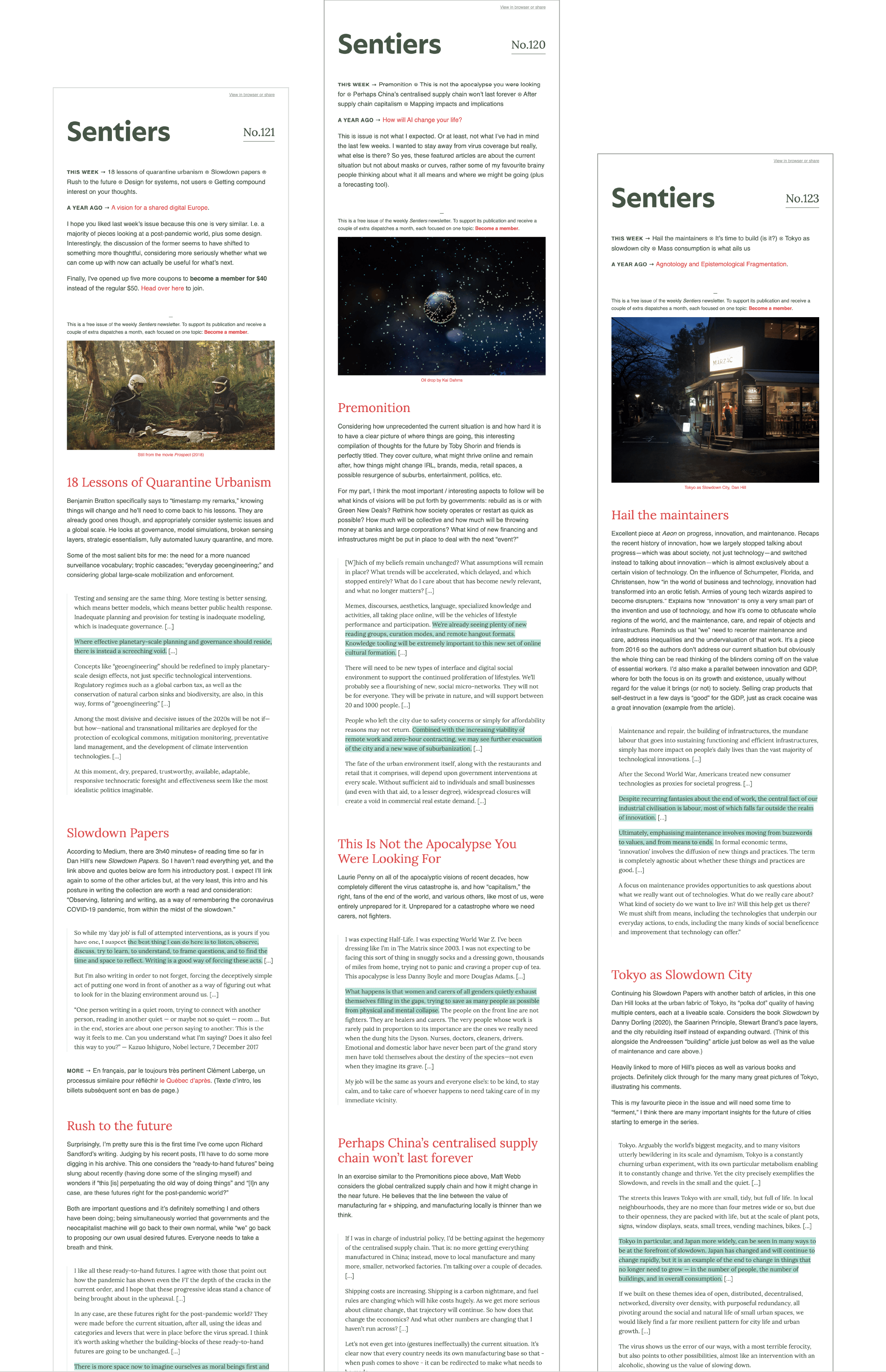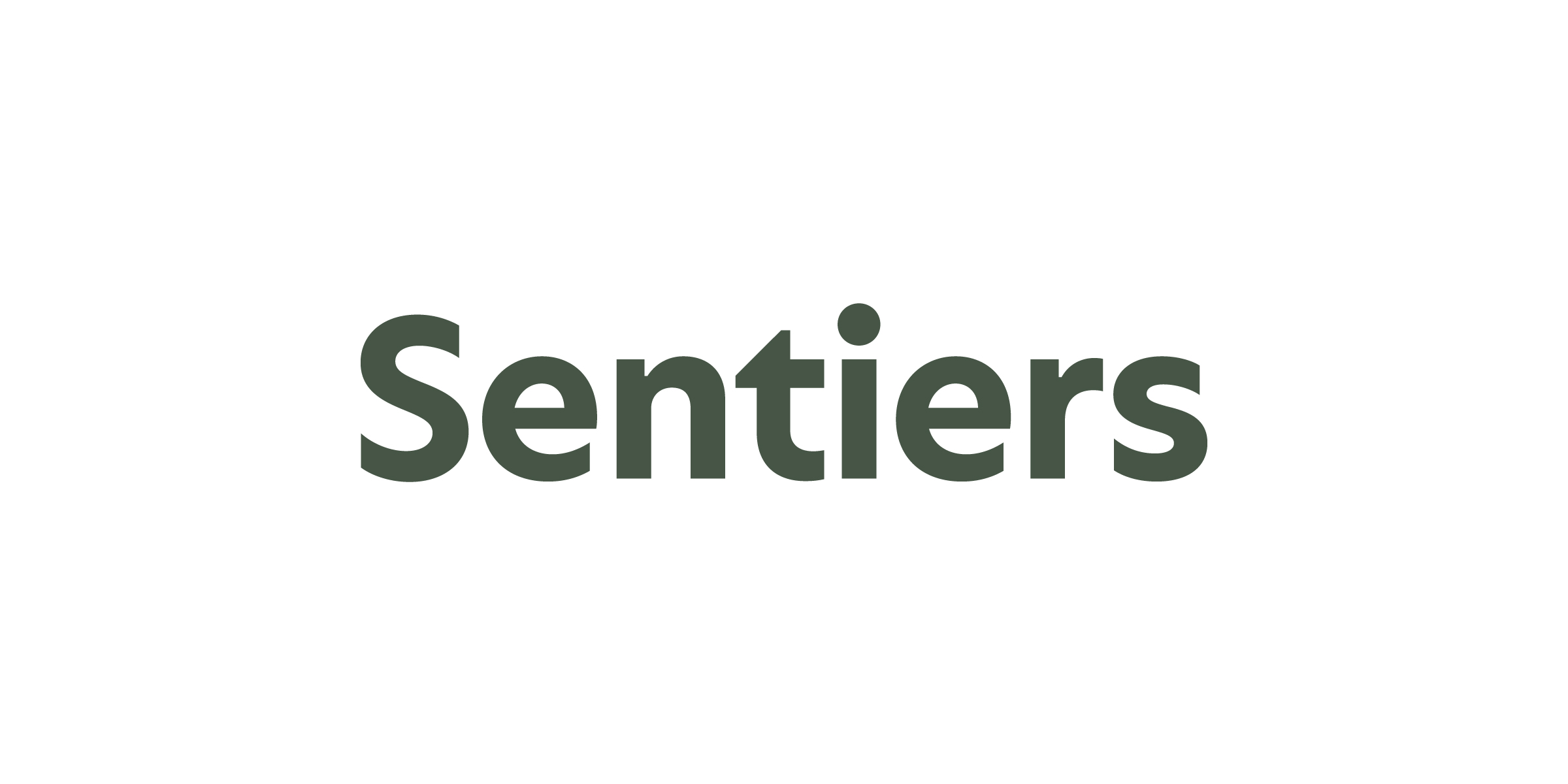What is a paid newsletter?
Many of us would be surprised to see a pop-up nowadays that asked us to pay for an email newsletter. With how rampant free newsletters are, paid newsletters are a weird new breed of emails, whose small but extremely loyal audiences run counter to the get-as-many-subscribers-as-humanly-possible methodology instilled in us.
How do you start one? Is it worth it? Who will actually pay for emails these days? Luckily, we were able to catch up with Sentiers, a paid newsletter publication, to get the answers and the details.
Some Questions About Sentiers:
Hi Patrick! Can you let us know a bit about your background?
I was a freelance web developer for years, then I guess you could say this understanding of technology helped expand my interests in more and more different domains, to building a reputation for “generally knowing about stuff,” which led me to more of a consultancy role, using a framing I call Thought Partnership.
How did the Sentiers newsletter start? Was there a reason that you picked email specifically?
During that transition from development to consultancy, I helped co-invent a print magazine called The Alpine Review. That was a very bold project focused on “observing the things that matter.” The intent was for it to be a tool to project our ideas and understanding, to lead us into consultancy projects in parallel. For various reasons, we put that project on hiatus.
Sentiers and email is my way to keep that thinking going in a kind of solo and MVP (Minimum Viable Product) form. Same curation, same topics, same sense making, on as light as possible infrastructure. Back then I was also curating a newsletter and “online magazine,” We Seek for e180 and loved the close interaction with readers and the much much higher engagement than with social media. With print you have very few “live” metrics to know what readers are interested in, so I also enjoyed that much quicker feedback loop. Considering that, making Sentiers a newsletter just made sense.

Sentiers is a newsletter that I look forward to and read all of. How do you discover and curate the articles that you feature?
Good to hear! I’d have to keep better track of this actually but it’s probably close to a 50/50 split between newsletters and Twitter. I subscribe to well over a hundred newsletters and I have a tightly curated main list on Twitter with interesting thinkers, I generally read pretty much every tweet from that (smallish) list. I then use Nuzzel to extract more links from a few other lists which I don’t read directly. Interesting articles I either append to that week’s issue in my text editor (Bear) or send to Instapaper.
How did you create and maintain a member supported newsletter? How do the paying subscriber dispatches differ from the free newsletter?
I used WordPress, Memberful, and Stripe to accept payments and paywall content, Memberful also syncs with Mailchimp so I can send email only to paid members. The plan for Dispatches is for three formats: first like weekly issues but on a single topic, then adding long-form articles and interviews as membership rises. I’m lucky that members right now are also getting onboard to support the weekly, not just for the extra content. I just explain that clearly (I hope!) on the website and remind readers of the program once in a while. That’s pretty much it.
Becoming a member helps sustain the free Sentiers weekly newsletter, and gets you some extra Dispatches to feed your curiosity. Use this RGE link to signup.
What has been your experience using Mailchimp as an ESP? Have you felt the need to tweak the design of the newsletter over the years? Have you run any tests with your emails?
It’s been good. One of the things I take seriously is the design of everything I do and Mailchimp is one of few solid solutions that let you completely design your template. That and the fact most other platforms offer support for their API (like Memberful and a WordPress plugin) are the two main factors that made me pick their platform, and keeps me there so far.
I have to say that as they seem to be switching ever closer to a marketing platform, it means I’m also constantly keeping an eye on other services but custom templates are a deal breaker for me. The template is constantly evolving design wise but with the new identity introduced 5-6 months ago, it’s been pretty stable. I run a spam test every week with Mail-Tester but I’ve run A-B tests only a couple of times. Mailchimp suggests having at a bare minimum 5000 subscribers for tests to be worth it and I’m “just” in the 3000s right now.
What challenges do you face with growing a membership supported newsletter? What is your biggest hurdle currently?
The biggest challenge is producing the extra content. Just writing the weekly takes quite a bit of time, adding the Dispatches is still not something I can consider as replacing a client revenue wise, although it’s going well. Right now the percentage of subscribers who are also paid members is rising so that’s excellent. The challenge then is growing the subscription base to the weekly. I’m at a level where it’s hard to get mentions in big enough “outlets” that it results in significant bumps in subscriptions, thus it’s largely through organic week on week growth. Getting large newsletters or accounts to talk about me without annoying them with spammy reach outs is thus the biggest hurdle.

What’s next for niche publications? Is the ad-based business model still relevant?
The use of the word “niche” is a bit misleading because it also relates to the size of your operation. For example I’m not sure the Stratechery niche is big enough for a medium to large scale operation but for a one person outfit, it’s a huge spot to be in and quite lucrative, if most reports are to be believed.
To me there are basically two types of publications, those who aim for a niche (although that can be relatively big, as mentioned above), and those aiming for an order of magnitude or two more members. The first usually aims for high engagement, and a close relationship with readers. They are better served with membership models and usually fit the relationship better. The latter will have lower engagement and higher churn but at such a scale that they can likely make more money. The ad-based model, which is (in my opinion) less respectful of the readers, fits this scale and churn model well, although more and more of them are going with subscription models too, often in addition to ads.
In terms of “next” I’d say probably bundles (multiple newsletters for one price). I’ve got a few articles lined-up on the topic but haven’t researched how it might work yet.
Some Questions About Thought Partners:
Can you explain what A Thought Partner is?
It’s an evolving model but my base definition is “someone who, through a practice of researching, reading, learning, asking questions, and writing, helps partners in developing their ideas, knowledge, and thinking.” The basic goal is to bring outside ideas and connect them to the needs, thinking, and strategy of an organization to broaden, strengthen, and accelerate their thinking. People are usually going full speed with no time to look sideways and to blindspots, I do that work for them.
Why do you think A Thought Partner is beneficial to an organization?
It’s pretty much impossible right now to effectively stay in business by looking exclusively at your own field and thinking no one, no event, no policy, no technology will ever affect how you work. Knowing what’s going on alongside your domain or further out on the edges is essential in planning. And honestly, it also makes for a more agile and creative brain to know more and look at things from different perspectives.

Do you feel “curators” are still valuable in our current web environment?
More than ever. We’ve seen time and again that algorithms picking content can fail and are often tweaked to reinforce a business model like advertising. Curators are not perfect either but people don’t approach a personal selection by one person the same way as they do the Facebook feed, for example.
Are there tools or frameworks for us to become Thought Partners within our own organizations? Or does that role work better as an outsider?
It probably works better as an outsider but that can sometimes work as simply outside of specific teams. Thought Partnership, in my experience, is often delivered as text, which means you can easily can pigeonholed as a content creator or a marketer. Nothing wrong with that per se, but you then get sucked in those departments’ deliverables. You need to at least be outside of them (or sales) to focus on looking outside the organization for insights.
Some Questions About Technology:
What are your thoughts on email tracking and privacy? Are there better ways of asking our subscribers how to serve them better?
Some people are arguing that there shouldn’t be tracking at all. I’d love to know nothing about individuals but have list-level stats like open rate and click rate. You can’t have those numbers without tracking individual emails but there’s no solid reason why I should be able to go to someone’s profile and know which email they clicked.
At a minimum it’s useful to have open-rate, in my case it’s pretty stable so when it suddenly goes down 4-5-6%, I know Gmail decided to send my emails to a folder or there was a problem elsewhere and I can try to fix it. It’s also a basic idea of your pertinence to readers.
Click-rates show me which links work best. I have quicker takes at the bottom of every issue and it’s often one of these that is the most clicked. So instead of getting me to focus on fewer topics, as people would expect that stat would do, it actually reminds me that my readers are interested in a broad variety of topics.
Do you believe AI will have a greater role in marketing? Do you think it will complement current processes or replace our roles?
Newsletters are often associated with marketing but that’s not a side of the “craft” I pay much attention to. In general though, I think AI is much much more interesting when considered as an augmentation to human work than a replacement. There’s more near-term potential there than in autonomous products, it’s a more realistic expectation, and it keeps humans in the loop. Near term, if it replaces roles it will be by making 8 people as effective as 10, not by taking over that role completely.

Do we “owe” anything to people who open and read our emails?
Respect for their time. I could get bigger bumps in memberships and subscriptions by being more aggressive but I tend to be overcautious and refrain from the vast majority of such “ploys.” In terms of content, I include anything I find interesting. In terms of the readers’ time and using “hacks,” I do only what I’m comfortable in receiving myself.
Lightning Round For Kicks
What is one piece of advice that you could give about building a brand through communication?
Be interesting. That very seldom means talking about yourself. Write about what you know and/or what you are curious about, not your product or services.
What other emails inspire you? Which company that you subscribe to does email the best?
For email and print, I’ve been a big fan of Kai Brach and his Offscreen magazine and Dense Discovery newsletter. I’m not sure if there are any lessons for companies there but everything Robin Sloan does is smart, well thought out, and worth your time. Hiut Denim and the DO lectures (same founders) are also great models of email communication (and comms in general). They built their business on emails. Lastly I’d said Jeff Sheldon with Ugmonk. Like Kai, everything is smart, thought through, well designed, and he does super clear communication with his personality front and center.
What was the most recent spam message you got in your spam box? What was the subject line?
“Hello! Lovely girl wants to talk with you! I hope for an answer!”
What is your favorite book?
Considering the topics I cover in Sentiers this will be blindingly unoriginal but the Pattern Recognition trilogy by William Gibson. I have to say though that over the last couple of years another trilogy as popped to mind even more often and it’s the Analog trilogy by my “internet friend” Eliot Peper. Spot on on so many things.
Caffeinated beverage of choice: Coffee, Tea, Soda?
Coffee.
To support the weekly newsletter, and get extra dispatches of deeper thinking, become a member of Sentiers. Use this RGE link to signup.



